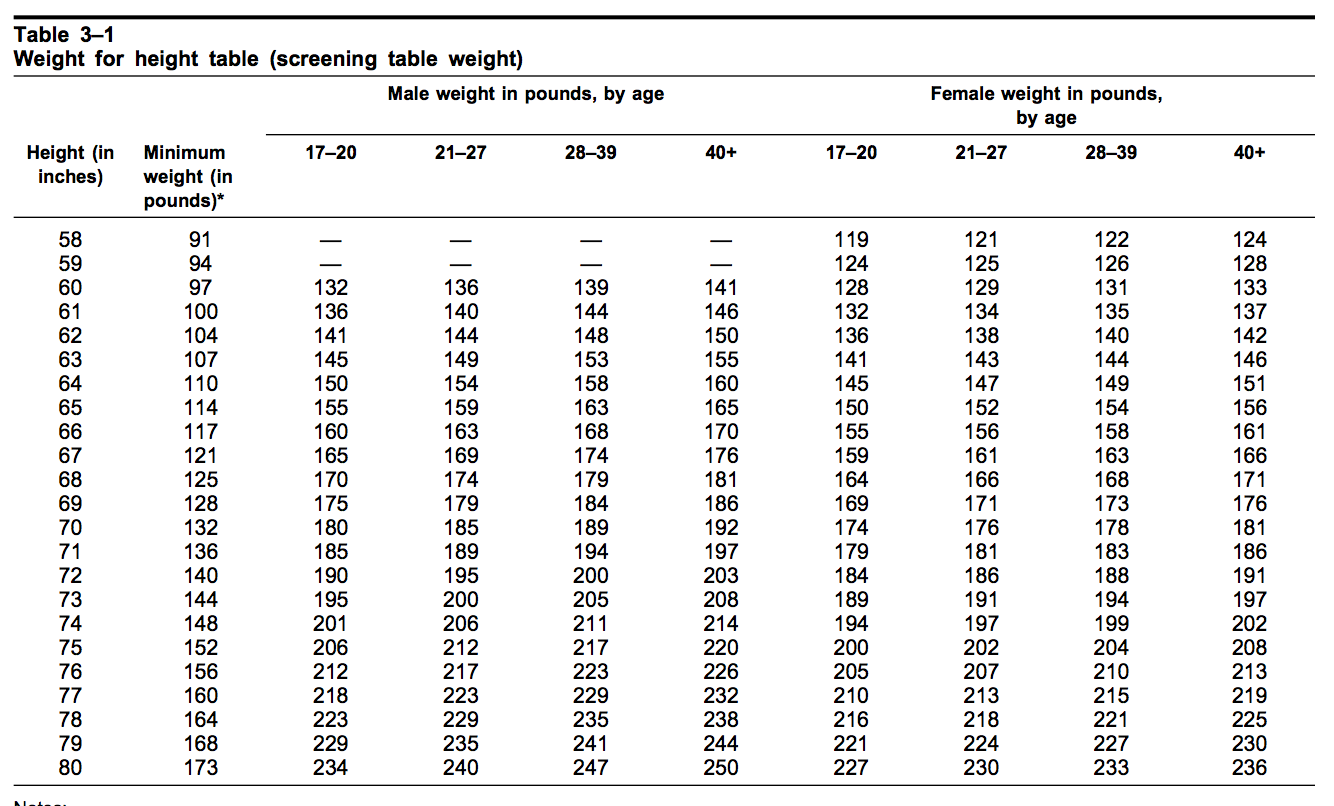The Army height and weight chart plays a crucial role in maintaining the physical fitness and readiness of military personnel. This chart serves as a standard for determining whether soldiers meet the required height and weight standards set by the Army. Adhering to these standards is essential not only for individual soldiers but also for the overall effectiveness and efficiency of military operations. It helps ensure that every member of the Army is fit to perform their duties effectively, which is critical in high-pressure situations.
The Army height and weight chart is not just a set of numbers; it reflects the Army's commitment to maintaining a fit and healthy fighting force. It is designed to provide guidelines that help soldiers assess their physical condition and make necessary adjustments to their fitness routines. By adhering to these guidelines, soldiers can improve their overall health and performance while minimizing the risk of injury.
In this article, we will delve deeper into the Army height and weight chart. We will explore its significance, the factors influencing the standards, and how it is applied in practice. Additionally, we will address common questions regarding the chart, and provide insights on how soldiers can meet the required standards through proper training and nutrition.
What is the Army Height and Weight Chart?
The Army height and weight chart is a standardized tool used by the United States Army to assess the physical fitness of its soldiers. It establishes specific height and weight parameters that soldiers must meet to be considered fit for duty. The chart includes a range of acceptable weights for each height, ensuring that soldiers maintain a healthy body composition.
Why is the Army Height and Weight Chart Important?
The Army height and weight chart is essential for several reasons:
- Readiness: Soldiers must be physically fit to perform their duties effectively.
- Health: The chart helps promote overall health and well-being among soldiers.
- Uniformity: It ensures all soldiers meet the same standards, fostering a sense of equality within the ranks.
- Performance: Maintaining the right weight can enhance a soldier's performance during training and combat.
How is the Army Height and Weight Chart Applied?
The Army height and weight chart is applied during regular assessments conducted by military personnel. Soldiers are measured for their height and weight, and their results are compared to the chart to determine if they meet the established standards. If a soldier does not meet the standards, they may be required to participate in a program to help them achieve the necessary weight.
Who is Affected by the Army Height and Weight Chart?
All active-duty soldiers, reserves, and National Guard members are subject to the Army height and weight chart. It is a crucial aspect of military life that affects soldiers from all backgrounds and ranks. The chart ensures that every individual is held accountable for their physical fitness and readiness to serve.
What Are the Consequences of Not Meeting the Army Height and Weight Standards?
Failing to meet the Army height and weight standards can lead to several consequences, including:
- Additional Training: Soldiers may be required to attend weight control programs.
- Performance Evaluations: A soldier's inability to meet the standards can negatively impact their evaluations.
- Reassignment: Soldiers may face reassignment to less physically demanding roles.
- Separation: In extreme cases, soldiers may be separated from the service.
How Can Soldiers Meet the Army Height and Weight Standards?
Meeting the Army height and weight standards requires a combination of proper diet, regular exercise, and commitment. Here are some tips for soldiers to consider:
- Nutrition: A balanced diet rich in fruits, vegetables, lean proteins, and whole grains is essential.
- Exercise: Regular cardiovascular and strength training exercises help maintain a healthy weight.
- Hydration: Staying hydrated is vital for overall health and can aid in weight management.
- Monitoring Progress: Regularly tracking weight and body measurements can help soldiers stay on target.
Can Body Composition Be Considered Alongside Height and Weight?
Yes, the Army does consider body composition alongside height and weight. Soldiers may undergo body fat assessments using various methods, such as skinfold calipers or bioelectrical impedance analysis. These assessments can provide a more comprehensive picture of a soldier's fitness level.
What Resources Are Available for Soldiers to Improve Their Fitness?
The Army provides numerous resources to help soldiers improve their fitness. These resources include:
- Fitness Centers: On-base fitness centers equipped with exercise machines and weights.
- Training Programs: Structured physical training programs designed for soldiers.
- Nutrition Counseling: Access to nutritionists and dietitians for personalized advice.
- Peer Support: Encouragement and motivation from fellow soldiers and leadership.
Conclusion
The Army height and weight chart is an essential tool for ensuring that soldiers maintain the physical fitness necessary to perform their duties. By adhering to the standards set forth in the chart, soldiers can enhance their readiness, health, and performance. The Army's commitment to physical fitness is vital for the success of its missions and the well-being of its personnel. With the right resources and determination, soldiers can achieve and maintain the required height and weight standards, contributing to a stronger, more effective military force.
Sandra Smith's Eyes: Real Or Enhanced?
Inger Stevens: A Star Shining Bright In Hollywood's Golden Era
Pamir Bürsin: The Rising Star Of Turkish Cinema


